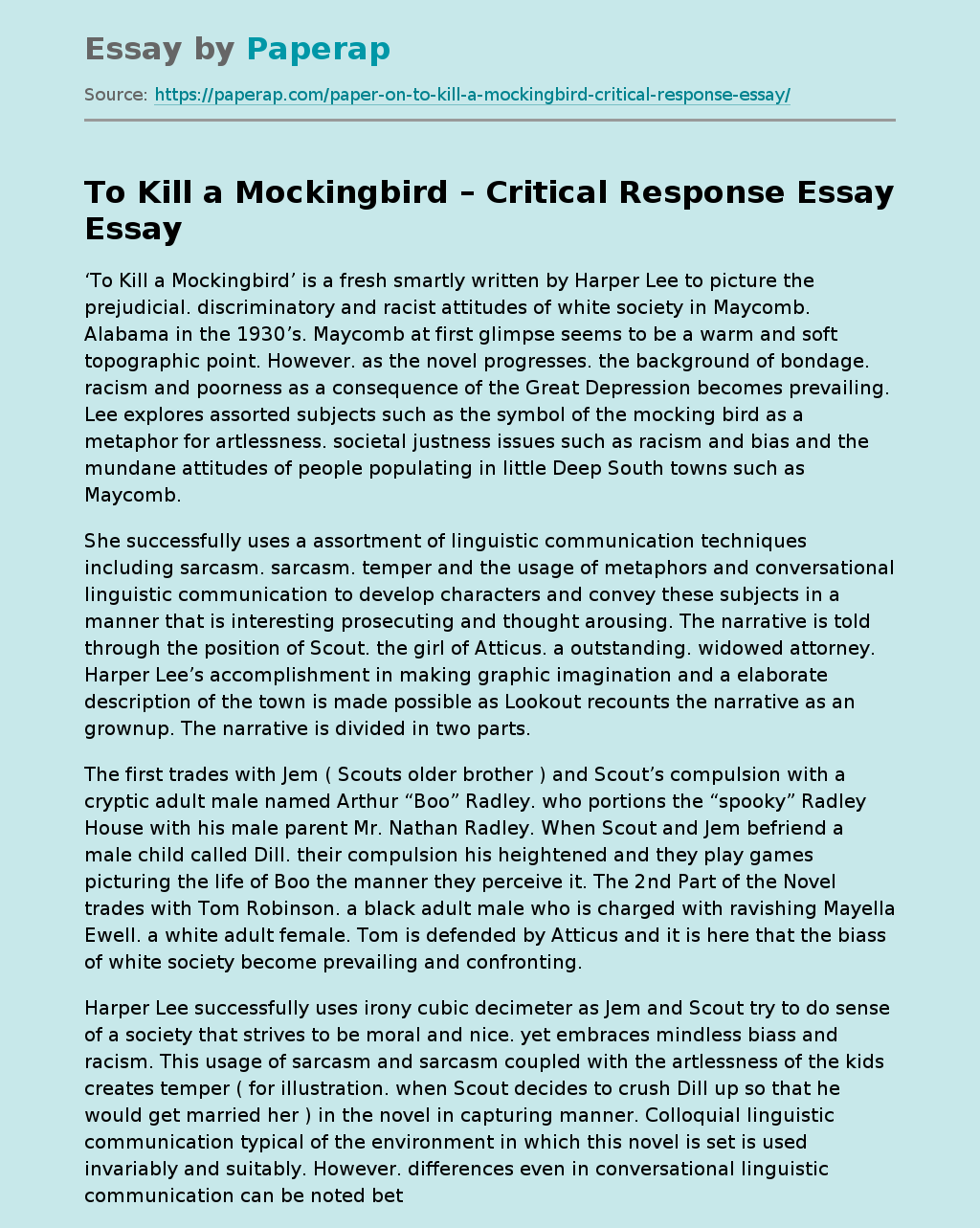To Kill a Mockingbird Critical Response Essay
‘To Kill a Mockingbird’ is a fresh smartly written by Harper Lee to picture the prejudicial. discriminatory and racist attitudes of white society in Maycomb. Alabama in the 1930’s. Maycomb at first glimpse seems to be a warm and soft topographic point. However. as the novel progresses. the background of bondage. racism and poorness as a consequence of the Great Depression becomes prevailing.
Lee explores assorted subjects such as the symbol of the mocking bird as a metaphor for artlessness. societal justness issues such as racism and bias and the mundane attitudes of people populating in little Deep South towns such as Maycomb.
She successfully uses a assortment of linguistic communication techniques including sarcasm. sarcasm. temper and the usage of metaphors and conversational linguistic communication to develop characters and convey these subjects in a manner that is interesting prosecuting and thought arousing.
The narrative is told through the position of Scout. the girl of Atticus. a outstanding. widowed attorney. Harper Lee’s accomplishment in making graphic imagination and a elaborate description of the town is made possible as Lookout recounts the narrative as an grownup. The narrative is divided in two parts.
The first trades with Jem ( Scouts older brother ) and Scout’s compulsion with a cryptic adult male named Arthur “Boo” Radley. who portions the “spooky” Radley House with his male parent Mr. Nathan Radley. When Scout and Jem befriend a male child called Dill.
their compulsion his heightened and they play games picturing the life of Boo the manner they perceive it. The 2nd Part of the Novel trades with Tom Robinson. a black adult male who is charged with ravishing Mayella Ewell. a white adult female. Tom is defended by Atticus and it is here that the biass of white society become prevailing and confronting.
Harper Lee successfully uses irony cubic decimeter as Jem and Scout try to do sense of a society that strives to be moral and nice. yet embraces mindless biass and racism. This usage of sarcasm and sarcasm coupled with the artlessness of the kids creates temper ( for illustration. when Scout decides to crush Dill up so that he would get married her ) in the novel in capturing manner. Colloquial linguistic communication typical of the environment in which this novel is set is used invariably and suitably. However. differences even in conversational linguistic communication can be noted between white and black society.
Calpurnia. a black maidservant looking after Scout and Jem. shows this really clearly. utilizing ‘White man’s language’ when in their company and altering to ‘black man’s jargon’ when in the company of dorsums. This divide in linguistic communication is used to underscore the divide in society between the two civilizations. Language is successfully used in the novel to develop characters and word picture. An illustration of this is the manner that the Ewell’s usage of disgusting linguistic communication as they address others. demoing their hapless instruction and societal standing.
Again. sarcasm is created here when Bob Ewell asserts himself better than a black adult male yet Tom Robinson speaks far more courteously and without disgusting linguistic communication. Mayella shows an utmost deficiency of instruction in her address as she struggles to happen the right words to show herself clearly. Atticus. on the other manus. uses formal linguistic communication of a high criterion and incorporates metaphors. sarcasm and temper in a manner that is impressive and frequently elusive. This is used to develop his character as a extremely respectful. open- minded. moral adult male.
Assorted subjects such as favoritism. bias. and societal justness are incorporated into this novel. The racialist and frequently unlogical biass of white society against black society ties into the subject of societal justness. a premier illustration being the result of Tom’s instance demoing how the universe we live in may non ever be merely and how justice depends on the attitudes of persons. However. possibly the most cardinal subject is the importance of the rubric “To kill a mockingbird” . This construct. the mindless persecution of an guiltless person. is used to depict Tom Robinson’s tribunal instance.
Mocking birds sing for people’s enjoyment. make no injury to the community and are a symbol of pureness and artlessness. Tom Robinson is perceived as a mocker when he is wrongly convicted over the colza of Mayella Ewell because of the biass of white society. Lee uses the repeat of the words “guilty… guilty… . guilty” to underscore the disapprobation of an guiltless adult male. or in a metaphorical sense. the violent death of a derisive bird. Boo Radley may besides be seen as a mocking bird.
In the beginning of the novel. he is perceived as a unsafe. frenzied person by the townspeople merely because of his cryptic character ( Boo seldom ventures out of the Radley House ) . though he had committed no offense. However. after Boo leaves gifts in a hole in a tree. puts a cover over lookout when she is standing in the cold and finally. saves Scouts life when Bob Ewell tries to kill her to seek retaliation for the demoralization of his household. during the tribunal instance. Jem and Scout realise that he is really a harmless. sort. person.
Again. we see how an guiltless adult male can be discriminated against by prejudice borne from ignorance. In decision. Harper Lee has achieved her intent in doing us believe about the manner we treat others and the effects that our ain biass may hold on their lives. She has achieved this by successfully conveying the common attitudes of white society in Deep South towns in the 1930’s ( particularly towards African Americans ) . and developing subjects and characters through her usage of linguistic communication devices such as conversational linguistic communication. sarcasm and sarcasm in a manner that is effectual and prosecuting.
To Kill a Mockingbird Critical Response Essay. (2017, Aug 13). Retrieved from https://paperap.com/paper-on-to-kill-a-mockingbird-critical-response-essay/

